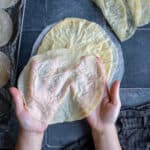Homemade Phyllo Dough Recipe
Make your own phyllo dough at home with this simple recipe! All you need are a few basic ingredients to create thin, pliable sheets of dough, perfect for a variety of sweet and savory dishes. Get ready to experience the satisfaction of homemade phyllo dough – it's easier than you might think!
- Prep Time: 1 and 1/2 hours
- Cook Time: 20 minutes
- Total Time: 0 hours
- Yield: 32 1x
- Category: Side Dish
- Method: Rolling Out
- Cuisine: Greek
Ingredients
Scale
- 1 medium egg (please read the note below for an egg-free option)
- 100 ml water, at room temperature
- 1 tablespoon vinegar (white or apple cider vinegar)
- 1/4 teaspoon fine salt
- 2 and 1/2 cups (345 g / 12 oz) all-purpose flour (or white bread flour)
- 1/2 cup cornstarch, for rolling out
- 1/4 cup oil (sunflower or vegetable oil), for brushing the dough when rolling it out
Instructions
Make the Dough:
- In a large mixing bowl, combine egg, water, vinegar, and salt using a whisk.
- Incorporate the flour into this mixture. Using your hands, mix until a unified dough is formed.
- Knead the dough either in the bowl or on a lightly floured surface for roughly 5 minutes. You're aiming for a smooth dough which will feel somewhat firm, not soft.
- Shape the dough into a ball and wrap it in plastic wrap. Allow it to rest for at least 30 minutes, or up to 1 hour. This rest period will relax the gluten in the dough, making it softer and easier to roll.
Divide the Dough Into Portions:
- After resting, unwrap the dough and shape it into a log. Slice this log into two equal parts vertically.
- Roll each piece into a log shape again, and divide each log into 16 equal pieces. As an alternative, you could use a kitchen scale to measure out 32 portions of dough, each weighing between 15-17 grams.
- Form each piece into a small ball, then cover them with a kitchen towel or plastic wrap. This will prevent the dough from drying out while you're working.
Roll Out the Small Circles:
- Dust your work surface with cornstarch. Place a dough ball on the surface, gently press it flat, and dust it with cornstarch. Roll it into a small circle (roughly 4 inches/10 cm in diameter). Set it aside and cover it to prevent drying.
- Repeat this process with each dough ball, ensuring to keep your work surface and each dough ball dusted with cornstarch.
Expand the Dough Circles:
- Cut two pieces of baking paper to fit the bottom of a non-stick pan (a 12-inch/30 cm pan works well).
- Place a small dough circle onto one piece of baking paper. Brush both sides of the circle lightly with oil, making sure it's well-coated but not overly saturated. Repeat with three more dough circles, placing them on top of one another and brushing each with oil.
- Place the second piece of baking paper on top of your stack of dough circles. Using a rolling pin, gently press down a few times to secure the circles and baking paper together. Now, roll the dough circles into a larger circle, about the size of the baking paper. The oil will prevent the circles from sticking together.
Cook The Fresh Phyllo:
- Warm your pan over medium-low heat. Place the larger phyllo dough circle (still sandwiched between baking paper) into the pan. Allow it to cook for about 15 seconds, flip it over, and cook the other side for 15 seconds.
- Repeat this flipping process once more. In total, the dough should be cooked for about 1 minute. Be careful not to over-cook the dough as it can become too crispy and difficult to separate later on.
Separate the Phyllo Layers:
- After cooking, carefully separate the dough circles while they're still warm. Don't allow them to cool before separating, as it will make the process more challenging. Once separated, let them cool and keep covered with a kitchen towel. They are ready to use.
Store the Phyllo Dough:
- If you're not using your homemade phyllo sheets right away, roll them in large parchment paper and place in a plastic bag. They can be stored in the refrigerator for up to a week.
- If you need to store them for a longer period, place the parchment-wrapped phyllo sheets in a resealable freezer bag. They can be frozen for up to 3 months. Thaw them in the refrigerator overnight before using.
Notes
- To make egg-free phyllo sheets, omit the egg and add an additional 3 tablespoons of water.
- Making thin phyllo sheets takes some time. Don't rush it, and take breaks if needed.
- Always cover the dough balls and rolled-out sheets to stop them from drying out.
- Dust your work surface and dough with cornstarch. It stops the dough from sticking.
- Try to roll out your dough as evenly as possible. It helps the sheets cook evenly.
- After partially cooking the stack of filo sheets in the pan, separate them while they're still warm. It's harder when they cool down.
- If you want a more traditional method, please read our explanation about how to do it in the post above.
Nutrition
- Serving Size:
- Calories: 60
- Sugar: 0 g
- Sodium: 20.6 mg
- Fat: 2 g
- Carbohydrates: 9.3 g
- Fiber: 0.3 g
- Protein: 1.2 g
- Cholesterol: 5.1 mg
Find it online: https://www.giverecipe.com/homemade-phyllo-dough-recipe/
